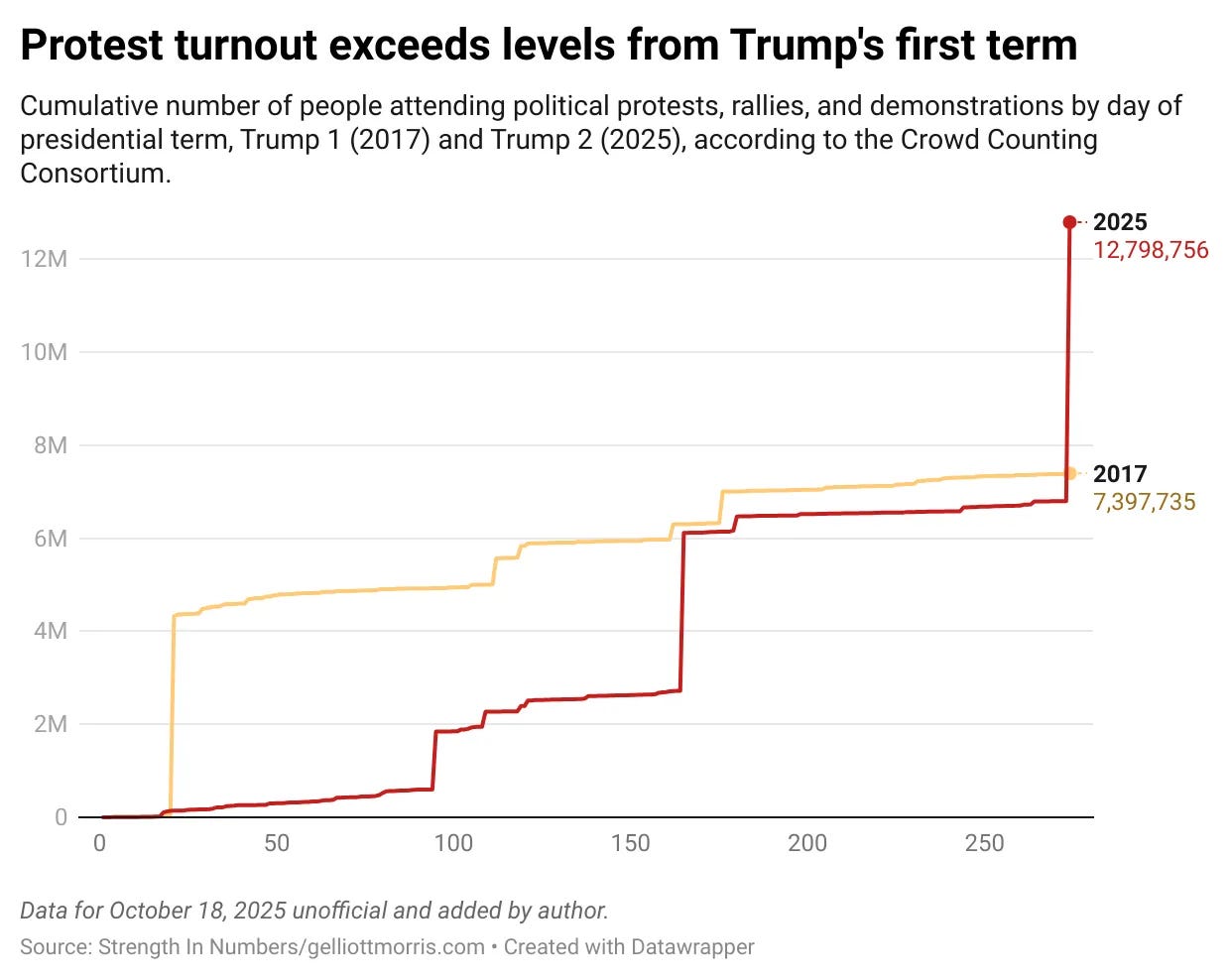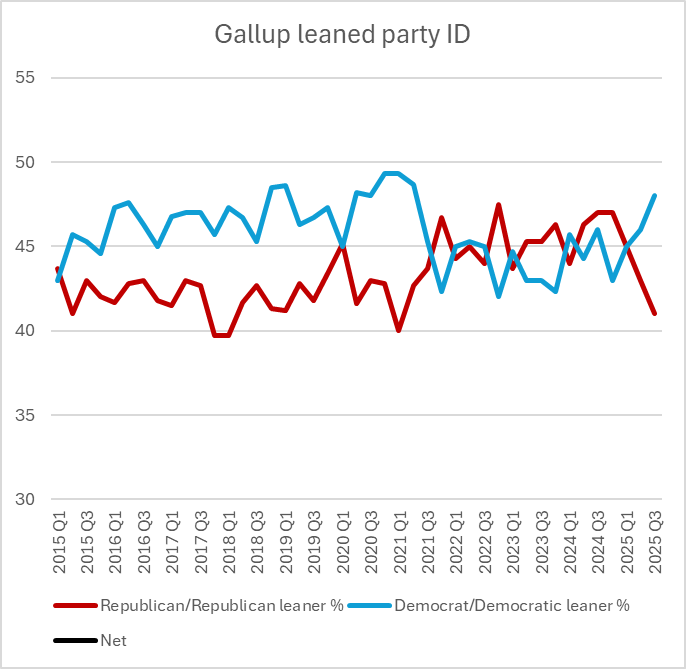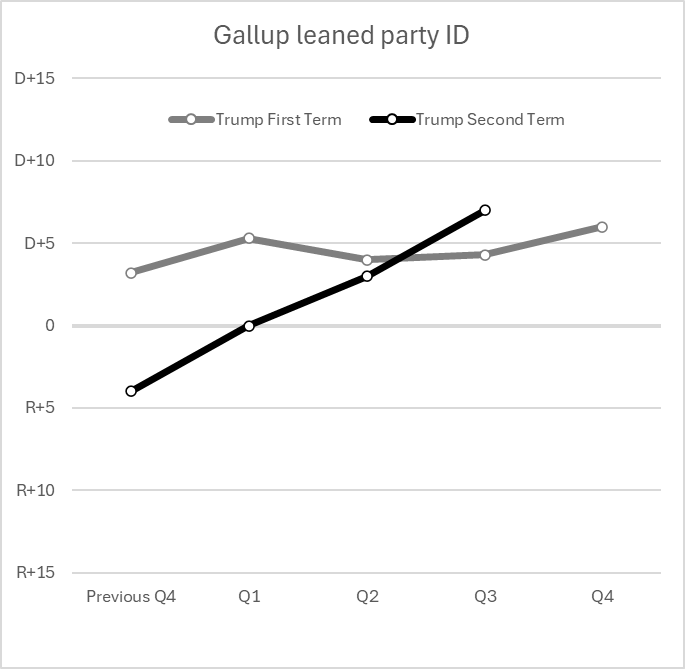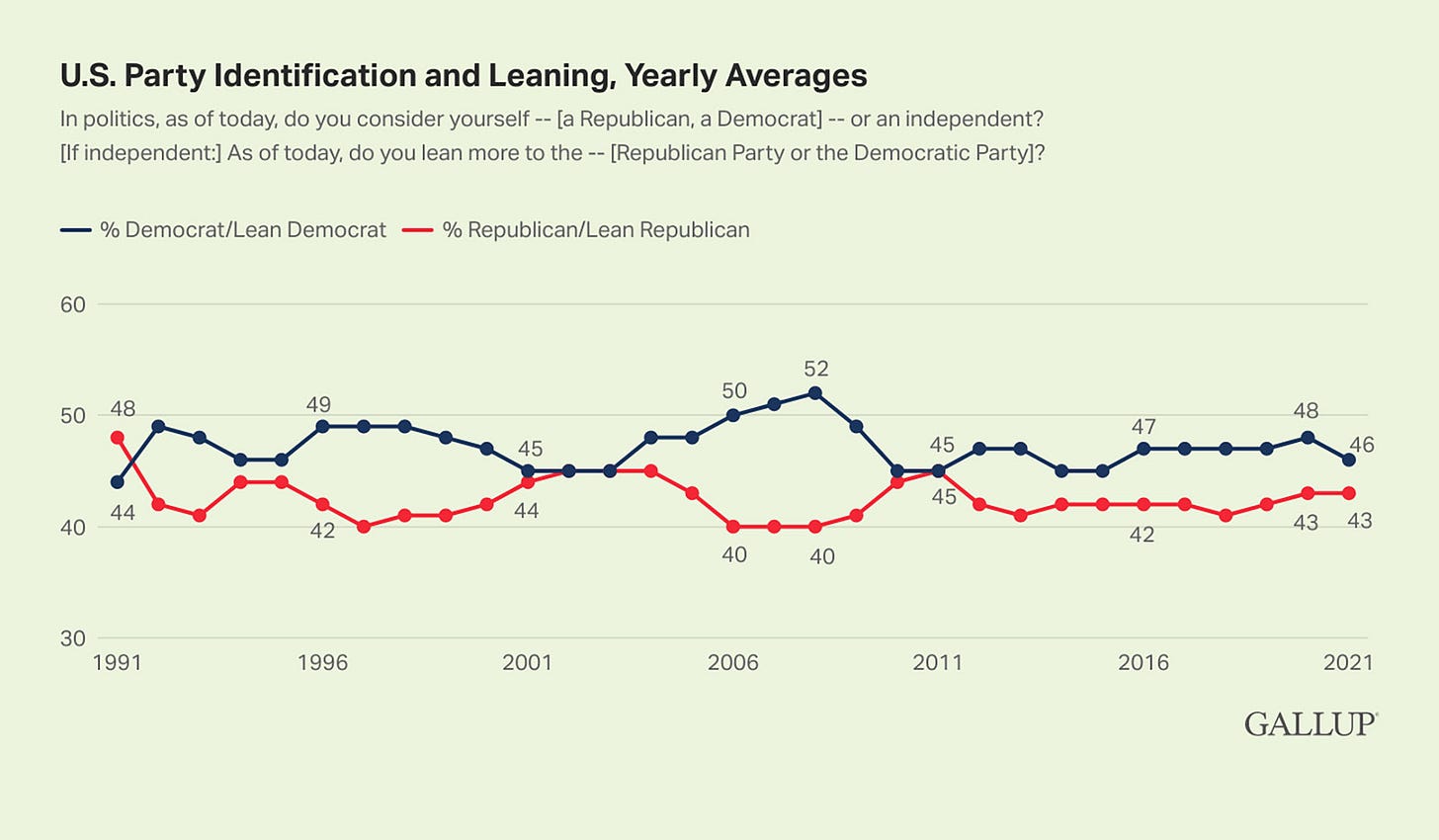No Kings Day numbers update; and Democrats pull ahead in national party ID polls
What should you make of this new data? Plus, the size of the anti-Trump, pro-GOP bloc; and polls on mass deportations. This is the Strength In Numbers October 2025 Q&A.
Dear readers,
Greetings from crisp autumn weather here in Washington, D.C. It’s time for my monthly question and answer/mailbag post. To all my new readers: Welcome! I do these posts once a month, seeing them as a way to interact with individual subscribers while still producing something beneficial for the full audience (so send in a question next time!).
This October Q&A includes at least one chart for every answer. Here’s a selection of questions to pique your interest:
What’s the political utility of the Oct. 18 No Kings Day demonstrations?
What should I make of Democrats pulling ahead in national party identification polls?
How many anti-Trump, pro-GOP voters are there?
How can we reconcile polls showing Americans favor mass deportations of unauthorized immigrants, and also favor extending a legal pathway to people who have been living here peacefully and following the law for years?
After the fallout of Trump’s economic agenda, especially his tariffs, how do Republicans still hold a lead on handling the economy? (Or do they?)
What are my long-term goals for Strength In Numbers?
Let’s dive straight in. You can send questions for next month to me via email (questions[AT] gelliottmorris<DOT>com) or leave them in the comments of this post.
As usual, the Q&A will be paywalled about halfway through as an exclusive for paying members of Strength In Numbers. You can sign up to read the full version here:
Why the No Kings Day protests matter
Paul asks:
How important is the October 18 No Kings march?
I have been thinking of the No Kings Day protests, and the other demonstrations against President Trump, within the context of two broader themes/questions in politics right now. The first is within the longer-run fight between Democratic activists, who have called on Congressional leaders to fight Trump and his administration more, and the leaders themselves — who, until recently, were very publicly ambivalent about the demands of the mobilized left wing of the party. Schumer publicly rebuked the “fight Trump” wing of the party back in March when he refused to shut down the government, for example, and Hakeem Jeffries has refused to endorse Zohran Mamdani for mayor of New York for fear of alienating his more centrist colleagues in the House.
But it seems to me that leadership has recently moved much closer to the camp saying Democrats need to engage in an all-out fight for the country. Jeffries and several other Democratic representatives attended No Kings Day rallies this weekend, with the former remarking “Showing up to express dissent against an out-of-control administration, that’s as American as motherhood, baseball and apple pie.”
The second way to look at the No Kings Day rallies is alongside the other data we have on just how energized Democrats are to participate in politics right now. Per our updated crowdsourced estimate, it looks like 5–6 million people turned out nationwide to stand up for democracy and protest Trump on Saturday. That is certainly a big shift in organization and energy to the left from the 2024 Biden and Harris campaigns (and an increase in turnout since the first No Kings Day in June). Meanwhile Democrats lead by 3 in the House generic ballot, according to the average at FiftyPlusOne.news, and they’ve increased their vote margin in the average special election since January by 15 points, according to data crunched by The Downballot.
This all mirrors my own polling on enthusiasm and the midterms. In our September Strength In Numbers/Verasight poll, voters who were most likely to say they’ll vote next year were 9 points friendlier to Democrats in the House. When that poll came out, I wrote:
Among the most engaged voters (those saying they are definitely or very likely to vote), the margin is still D+5 (50–45). We also asked voters to rate their interest in the election on a scale from 1 to 10: Among the 10-out-of-10 voters, Democrats lead 55–41 (just 4% undecided) in the generic ballot.
So, how important is the march? Well, in the sense that it confirms other data we’re seeing about the public, it’s not that important — I’m not shifting my priors significantly in any direction. Informed observers already knew that the public is pissed and broadly pro-democracy.
But in the sense that No Kings is evidence to party leadership that Democrats want them to publicly fight for democracy and sensible government, I’d say it’s very important. And if you compare how leadership is acting now (holding firm on day 21 of a government shutdown, now the second longest in history) to where they were six months ago, I’d say the proof is in the pudding.
Democrats regain lead on national party ID
Chris says:
I’d love to see how party identification age distributions have changed over time (like the last 50 years).
This is a very timely question, since Gallup just released its quarterly estimate of national party identification on Oct. 20. Here’s a graph of this data going back to 2015 (hat tip to pollster and friend of the blog Will Jordan):
According to Jordan, Democrats hold a 7-point lead on party ID now, their highest since before Joe Biden was elected president. Moreover (and more to the point in my first answer to this month’s Q&A), that 7-point lead is actually larger than the equivalent Democratic Party ID advantage in Q3 2017, during Trump’s first term:
Again, thanks to Will Jordan for posting these graphs.
Here’s another long-term graph from Gallup, looking at yearly party ID from 1991 to 2021 (I couldn’t find a more updated long-term graph). This quarter’s D+7 reading is close to the lead Democrats had for most of the past decade, including in 2012 during Barack Obama’s re-election:
I’ll note this is very different from the party registration data that made such a big splash a few months ago (the NYT said it was a “crisis“ for Democrats). My advice back then was to take the catastrophic framing with a grain of salt, since by mid-year, the data was pretty stale (not a lot of people register to vote in the off year), and so was likely hiding the shift toward Democrats we were seeing in polls. Gallup confirms that take.
OK, there you go, Chris — a timely long-term party ID chart, as requested.
How many anti-Trump, pro-GOP voters are there?
Anon asks:
I think a lot of people disapprove of Trump, but would vote for him - or another Republican - again, rather than for a Democrat. It might be good to get a handle on how big that pool is.
Great question, and I can give you a direct answer from our Strength In Numbers/Verasight poll from September — at least as it relates to the midterms.
Keep reading with a 7-day free trial
Subscribe to Strength In Numbers to keep reading this post and get 7 days of free access to the full post archives.






